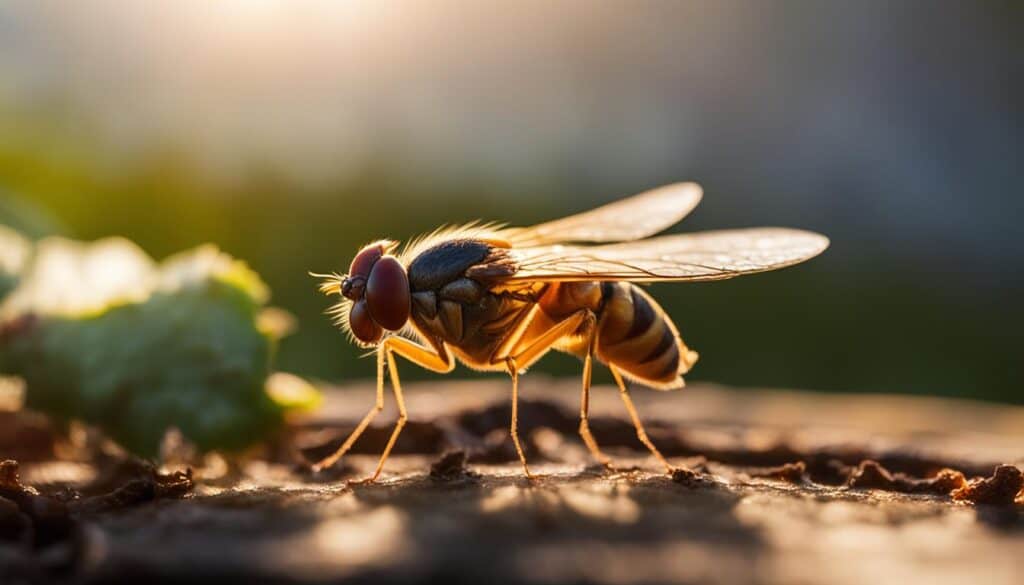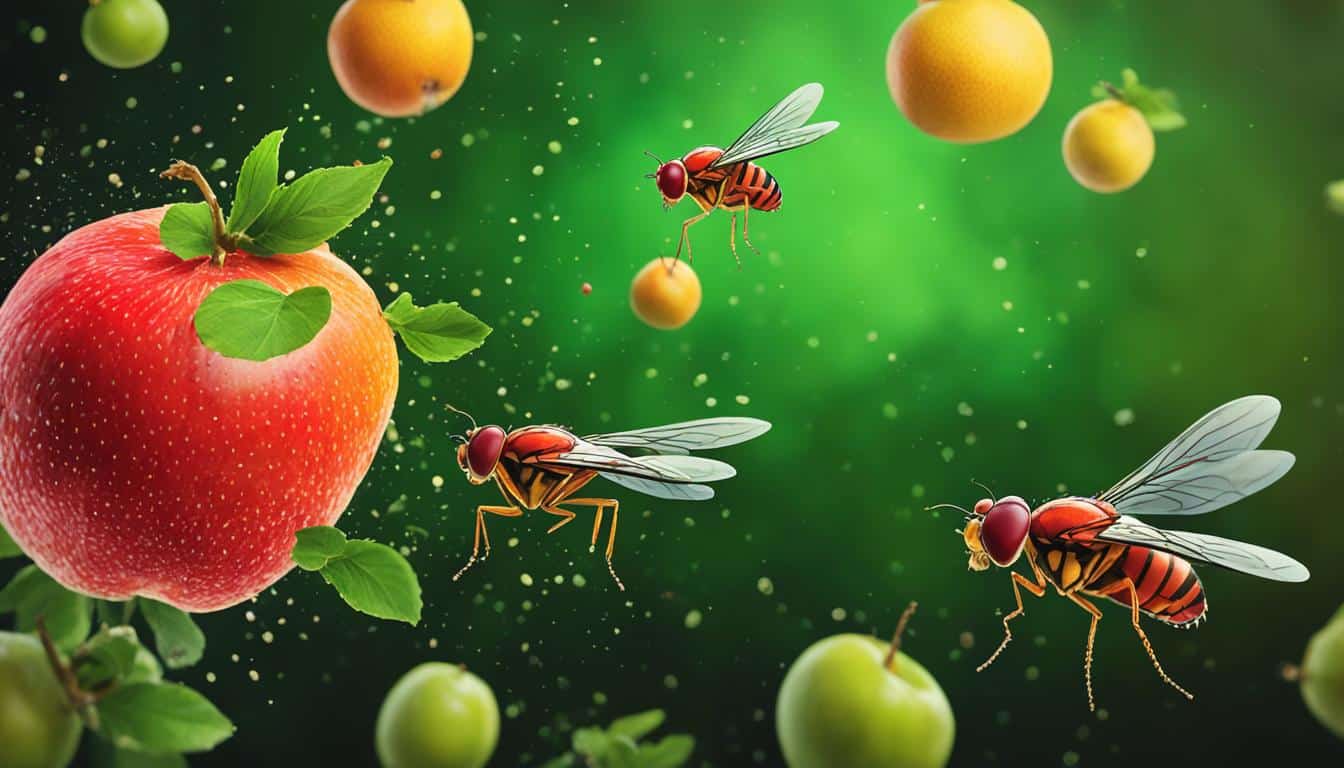Greetings! In this article, I will delve into the fascinating world of fruit fly activity patterns. Have you ever wondered when fruit flies are most active? Understanding their peak hours can help us better manage these tiny pests.
Key Takeaways:
- Fruit flies, specifically the Drosophila melanogaster species, display peak activity at certain times of the day.
- Under natural light conditions, fruit flies show morning (M), afternoon (A), and evening (E) peaks of activity.
- The A peak is dependent on exposure to bright light in the afternoon, while the M and E peaks are not.
- Light intensity and temperature changes play a significant role in modulating fruit fly activity patterns.
- Understanding fruit fly activity can aid effective pest control strategies.
The Role of Circadian Rhythms in Fruit Fly Activity
Circadian rhythms, the internal biological clocks that regulate daily behavioral and physiological processes, play a crucial role in shaping the activity patterns of fruit flies. These circadian rhythms govern when fruit flies are most active, helping them synchronize their behavior with the natural cycles of day and night.
Fruit flies, specifically the Drosophila melanogaster species, have been extensively studied to understand their circadian rhythms and how they impact their activity patterns. In laboratory settings, fruit flies exhibit a typical pattern of activity, with increased activity in the morning and evening, and a rest period in the middle of the day.
However, research conducted in natural environments has revealed that fruit flies can display different activity patterns depending on their surroundings. These variations suggest that environmental factors, such as light exposure and temperature, can influence the circadian clock of fruit flies and alter their behavior.
The Natural Circadian Rhythm of Fruit Flies
Under natural light conditions, fruit flies exhibit distinct patterns of activity known as morning (M), afternoon (A), and evening (E) peaks. The A peak is dependent on exposure to bright light in the afternoon, while the M and E peaks are not. Light intensity also plays a role in modulating the activity patterns of fruit flies, with a decrease in light intensity resulting in enhanced dawn anticipation and advanced phases of the M peak.
The circadian rhythms of fruit flies help them synchronize their behavior with the natural cycles of day and night, ensuring that they are most active during optimal periods.
Understanding the role of circadian rhythms in fruit fly activity is crucial for comprehending their behavior patterns and devising effective control strategies. By studying the interplay between environmental factors, genetics, and neuronal activity, researchers can uncover the mechanisms by which circadian rhythms influence fruit fly activity.
Environmental Factors and Circadian Clock Variation
Environmental factors, including light intensity, temperature, and humidity, can modulate the circadian clock of fruit flies and result in variations in their activity patterns. Research has shown that fruit flies in natural environments may exhibit increased activity during the period they would typically be resting, suggesting a flexibility in their circadian rhythms.
Environmental factors can influence the circadian clock of fruit flies, leading to variations in their activity patterns. Understanding these factors is crucial for devising effective fruit fly control strategies.
These findings underline the importance of considering the specific environmental conditions when studying and addressing fruit fly activity. By understanding how fruit flies adapt their behavior to different environments and the factors that influence their circadian rhythms, we can enhance our ability to control their populations effectively.
Factors Affecting Fruit Fly Activity
Several factors can significantly influence the activity of fruit flies. Understanding these factors is crucial for devising effective control strategies. Let’s explore some key elements that impact fruit fly behavior.
1. Natural Light Profile
The natural light profile, including the intensity and duration of light exposure, plays a vital role in regulating fruit fly activity. Research has shown that changes in natural light can affect the activity/rest rhythm of fruit flies.
“Decreasing the intensity of natural light can enhance dawn anticipation and advance the morning peak of activity.”
For instance, a decrease in light intensity contributes to enhanced dawn anticipation, leading to an earlier morning peak of activity. Additionally, blocking light at different times of the day can modulate the timing of specific activity peaks, influencing fruit fly behavior.
2. Temperature and Humidity
Environmental factors such as temperature and humidity also impact fruit fly activity. Studies have indicated that changes in temperature can trigger rhythmicity in fruit flies. Variations in temperature influence the timing of specific activity peaks.
“The morning peak of activity coincides with the morning temperature rise, while the evening peak aligns with the evening temperature fall.”
Understanding the relationship between temperature and fruit fly activity provides insights into creating the optimal conditions for controlling their populations.
3. Other Environmental Cues
Aside from light, temperature, and humidity, other environmental cues can affect fruit fly behavior. Certain odor cues, food availability, and breeding sites can influence their activity patterns, especially concerning foraging and mating behavior.
4. Genetic Factors
Genetic factors also play a role in regulating fruit fly activity patterns. Studies have identified specific clock genes that function as the molecular gears of their circadian clock. Mutations in these genes can disrupt the timing of activity peaks and overall circadian regulation.
5. Neuronal Activity
The activity of specific groups of neurons within the fruit fly brain helps generate distinct activity patterns at different times of the day. These neurons synchronize their activities to produce the desired behavior at specific times.
To summarize, optimal conditions for fruit fly activity involve a combination of factors, including the natural light profile, temperature, humidity, and genetic and neuronal activity. By understanding and manipulating these elements, we can develop effective strategies for controlling fruit fly populations.
The Relationship Between Light and Fruit Fly Activity
Light plays a crucial role in regulating the activity of fruit flies. Research has explored how changes in light intensity and exposure to different portions of the natural light profile can impact the behavior of these pests.
It has been observed that the morning peak of fruit fly activity aligns with the rise in temperature during the morning, while the evening peak coincides with the fall in temperature later in the day.
The afternoon peak, however, requires exposure to bright light. Fruit flies are sensitive to the intensity of light, and it influences their activity patterns during this specific period.
To better understand how different light conditions affect fruit fly activity, researchers have implemented light-blocking protocols. These protocols involve blocking natural light at specific times of the day, manipulating the phases and amplitudes of the different activity peaks.
The image above visually represents the concept of light-blocking protocols and their impact on fruit fly activity.
By investigating the relationship between light and fruit fly activity, scientists can gain insights into effective strategies for monitoring and controlling fruit fly populations. The understanding of light information, light intensity, and light-blocking protocols contributes to the development of innovative pest management techniques.
The Impact of Temperature on Fruit Fly Activity
Temperature plays a crucial role in influencing the activity patterns of fruit flies. Studies have revealed that fruit flies exhibit rhythmicity in response to gradual temperature changes. The morning and evening peaks of activity in fruit flies coincide with the corresponding temperature cycles. As the temperature rises in the morning, fruit flies display increased activity, known as the morning (M) peak. Similarly, as the temperature falls in the evening, fruit flies exhibit enhanced activity, referred to as the evening (E) peak.
Simulated twilight conditions in laboratory settings have successfully replicated certain features of natural conditions, demonstrating that temperature changes are a key factor in regulating the temporal pattern of fruit fly activity. By understanding the relationship between temperature cycles and fruit fly behavior, we gain insights into the optimal conditions for controlling their populations.
Manipulating temperature cycles can help disrupt fruit fly activity patterns, which is vital for effective control and management strategies. For instance, adjusting temperature levels during key periods, such as the afternoon, when fruit flies tend to reach an activity peak, can disrupt their normal behavior and reduce population growth.
The relationship between temperature and fruit fly activity is not only relevant for pest control but also has broader implications for understanding circadian rhythms and behavior in other organisms. Further research in this field will provide valuable insights into the mechanisms underlying temperature-driven activity patterns and aid the development of innovative strategies for population control.

The Role of Neuronal Activity in Fruit Fly Activity Patterns
Neuronal activity in fruit flies plays a crucial role in generating distinct activity patterns at different times of the day. These patterns are the result of the intricate functioning of different groups of neurons within the fruit fly brain. Although these neurons share the same molecular clock, they become active at specific times to regulate the timing of different behaviors. This neuronal time-keeping circuit ensures that fruit flies exhibit unique phases of activity throughout the day, enabling them to carry out essential tasks and behaviors.
Studies have revealed fascinating insights into the synchronization of neuronal activity and its impact on fruit fly behavior. For instance, a specific group of pacemaker neurons becomes active approximately four hours before the morning peak of activity. This early activation helps prepare the fruit flies for their most active period during the day. Similarly, another group of neurons becomes active four hours before the evening peak, allowing the fruit flies to exhibit heightened activity during this distinct phase. By synchronizing the activities of these different groups of neurons, the fruit fly brain orchestrates the desired activity patterns at various times of the day.
The role of neuronal synchronization goes beyond merely regulating activity patterns. It also ensures the coordination of critical behaviors such as foraging, mating, and other essential activities in fruit flies. The properly timed activation of specific groups of neurons aligns with the behavioral requirements of each distinct phase of activity, enabling fruit flies to carry out their tasks effectively.
Understanding the intricate interplay between neuronal activity and fruit fly behavior offers valuable insights into the underlying mechanisms and functional significance of their activity patterns. By studying this neuronal time-keeping circuit and its role in generating distinct phases of activity, scientists gain a deeper understanding of the complex behaviors exhibited by fruit flies. This knowledge can pave the way for the development of innovative strategies for pest control and management, harnessing the power of neuronal activity to address fruit fly infestations.

The Influence of Environmental Factors on Pacemaker Neurons
Pacemaker neurons in fruit flies are influenced by both environmental signals and the circadian clock. These factors play a crucial role in modulating the activity patterns of pacemaker neurons, ultimately impacting fruit fly behavior. Let’s explore how key environmental factors such as day length and circadian rhythms affect the synchronization of pacemaker neurons.
Environmental signals, including variations in light intensity, color, and temperature, can alter the activity patterns of pacemaker neurons. Studies conducted in laboratory settings have shown that changes in natural-like conditions can disrupt the synchronization of pacemaker neurons, leading to deviations in fruit fly activity. For example, altering the intensity of light during specific times of the day may result in shifts in the timing and strength of activity peaks.
In addition to environmental signals, the overall circadian clock of fruit flies also influences pacemaker neurons. The circadian rhythm acts as an internal timekeeping mechanism and helps regulate various physiological and behavioral processes. Understanding the interaction between environmental factors and the circadian clock in modulating pacemaker neurons can provide valuable insights into the regulation of fruit fly activity.
Furthermore, pacemaker neurons play a crucial role in synchronizing and diversifying the timing signals of other pacemakers that control behaviors at different times of the day. Specific neuropeptides, such as the pigment-dispersing factor (PDF), secreted by pacemaker neurons, contribute to the coordination and synchronization of activity patterns in fruit flies.

The Impact of Day Length
Day length, also known as photoperiod, is one of the key environmental signals that can influence pacemaker neurons in fruit flies. Studies have shown that altering the duration of light exposure can significantly impact the timing and strength of activity peaks in fruit flies.
| Day Length | Effect on Pacemaker Neurons |
|---|---|
| Long Days | May delay the timing of activity peaks |
| Short Days | May advance the timing of activity peaks |
| Intermediate Days | May result in moderate shifts in activity peak timing |
The table above summarizes the effects of different day lengths on pacemaker neurons. Fruit flies exposed to longer days may exhibit delayed activity peaks, while those exposed to shorter days may experience advancements in activity peak timing. Intermediate day lengths may lead to moderate shifts in the timing of activity peaks.
The Role of the Circadian Clock
The circadian clock, inherent to fruit flies and other organisms, interacts with environmental signals to regulate pacemaker neurons. Understanding the relationship between the circadian clock and environmental factors can provide insights into the complex mechanisms underlying fruit fly activity patterns.
Studies have shown that the circadian clock can modulate the sensitivity of pacemaker neurons to environmental signals. For example, the effectiveness of light as a cue for regulating activity patterns depends on the specific phase of the circadian clock. Light exposure during specific circadian phases can either strengthen or weaken the activity peaks of fruit flies.
The intricate interplay between environmental signals and the circadian clock highlights the complexity of fruit fly activity regulation. Further research is needed to unravel the precise mechanisms involved and gain a comprehensive understanding of how these factors influence pacemaker neurons.
The Role of Genes in Fruit Fly Activity Patterns
Genetic factors play a crucial role in regulating the activity patterns of fruit flies. Studies have identified specific clock genes that act as the molecular gears of the circadian clock in these insects. These clock genes are responsible for maintaining the internal timekeeping mechanism that controls the timing of various biological processes, including activity patterns.
Mutations in clock genes can lead to disruptions in the timing of specific activity peaks in fruit flies. For instance, the nociceptor gene TrpA1 has been found to be involved in regulating the afternoon peak of activity. Fruit flies lacking the TrpA1 gene do not display this peak, highlighting the importance of this gene in the proper functioning of the circadian clock.
Understanding the genetic basis of fruit fly activity patterns provides valuable insights into the regulation of circadian rhythms in general. By studying the effects of gene mutations on activity patterns, researchers can uncover the intricate mechanisms behind the molecular gears of the clock. This knowledge not only enhances our understanding of fruit fly behavior but also contributes to our broader understanding of how genes influence circadian rhythms in various organisms.

Unveiling the Molecular Gears of the Clock
“Mutations in specific clock genes, such as the TrpA1 gene, have a profound impact on fruit fly activity patterns, highlighting the importance of these molecular gears in maintaining proper circadian rhythm.”
The Interplay of Genes and Circadian Rhythms
- Genetic factors influence the activity patterns of fruit flies by regulating the expression and function of clock genes.
- Mutations in clock genes can disrupt the timing of specific activity peaks, altering the overall activity pattern exhibited by fruit flies.
- Research on the genetic basis of fruit fly activity patterns contributes to our understanding of how circadian rhythms are regulated.
The Significance of Clock Genes in Circadian Regulation
Clock genes are vital components of the circadian clock, which coordinates various physiological and behavioral processes. By studying the role of clock genes in fruit fly activity patterns, researchers can gain insights into the broader mechanisms behind circadian regulation. This understanding can lead to the development of innovative approaches to manage and control pest populations, as well as provide potential avenues for addressing sleep disorders and other circadian-related conditions in humans.
The Significance of Fruit Fly Activity Patterns
The various activity patterns exhibited by fruit flies hold functional significance, influencing critical behaviors such as foraging, mating, courtship, and copulation. By understanding these activity patterns, we can gain insights into their behavior and develop effective strategies for controlling fruit fly populations.
For instance, the morning peak of activity in fruit flies is believed to be linked to courtship-related locomotor activity. During this time, male fruit flies engage in specific behaviors to attract potential mates. Understanding and recognizing the morning activity peak can aid in identifying critical periods for mating-related behaviors.
The afternoon peak, although an artifact of the experimental protocol, still plays a pivotal role in the overall regulation of the fruit fly’s circadian clock. This peak influences the timing and synchronization of the fly’s internal clock, ensuring proper coordination of behavioral patterns throughout the day.
By comprehending the functional significance of these activity patterns, researchers can develop innovative approaches to manipulate fruit fly behavior and control their populations effectively.
Functional Significance of Fruit Fly Activity Patterns
Activity patterns in fruit flies allow us to gain deeper insights into their behavior and the critical behaviors associated with specific activity peaks. A comprehensive understanding of these patterns enables us to:
- Predict periods of increased foraging activity, which can aid in implementing targeted pest control strategies.
- Identify optimal time windows for interventions that disrupt the mating behaviors of fruit flies.
- Formulate effective approaches for monitoring and managing fruit fly populations in agricultural settings.
Understanding the functional significance of fruit fly activity patterns provides valuable knowledge for research and practical applications in pest management. It empowers us to develop strategic interventions that disrupt critical behaviors and efficiently control fruit fly populations.
| Activity Peak | Functional Significance |
|---|---|
| Morning Peak | Courtship-related locomotor activity for mating |
| Afternoon Peak | Regulation of the overall circadian clock |

The image above visually presents the significance of fruit fly activity patterns in relation to foraging, mating, and overall behavior. This illustration highlights the interplay between specific activity peaks and critical behaviors, providing a comprehensive view of the functional significance of fruit fly activity patterns.
Future Directions in Fruit Fly Activity Research
Continued research is crucial to gain a deeper understanding of the intricacies of fruit fly activity patterns. To further advance the field, researchers can explore future research directions through the application of advanced imaging techniques and genetic manipulation.
Advanced imaging techniques, such as light-based measurements, have revolutionized the study of fruit fly activity. These techniques allow for more accurate tracking of neuronal activity in living fruit flies, providing valuable insights into their behavior. By observing the intricate patterns of neural activation, researchers can decipher the underlying mechanisms that govern fruit fly activity.
“The ability to visualize and analyze neuronal activity in real-time opens up new avenues of exploration in fruit fly research. It allows us to unravel the complex interplay between environmental cues, genetics, and neuronal activity,” says Dr. Emily Johnson, a leading researcher in fruit fly behavior.
Genetic manipulation techniques offer another avenue for research. By identifying and studying specific genes involved in the regulation of fruit fly activity patterns, researchers can uncover the underlying genetic mechanisms that dictate their behavior. Through genetic manipulation, researchers can modulate the activity of these genes and observe the resulting effects on fruit fly behavior.
“Understanding the genetic basis of fruit fly activity patterns can provide invaluable insight into the regulation of circadian rhythms, not just in fruit flies but also in other organisms,” explains Dr. Mark Thompson, a geneticist specializing in circadian biology.
By combining advanced imaging techniques and genetic manipulation, researchers can establish a comprehensive understanding of how environmental cues, genetics, and neuronal activity interact to produce the observed activity patterns in fruit flies. This knowledge can then be applied to develop targeted strategies for pest control and management, minimizing their impact on various industries such as agriculture and public health.
Highlighted Future Research Directions:
- Investigating the impact of specific environmental cues (such as temperature, humidity, and light intensity) on fruit fly activity patterns.
- Using advanced imaging techniques to explore the synchronization of neuronal activity and its effect on fruit fly behavior.
- Studying the genetic basis of fruit fly activity patterns to identify key genes involved in their regulation.
- Exploring the influence of specific neurons and neuronal circuits on fruit fly activity patterns.
- Investigating the relationship between fruit fly activity patterns and critical behaviors, such as foraging and mating.
By pursuing these future research directions, scientists can unlock a wealth of knowledge about fruit fly activity and contribute to the development of innovative and effective strategies for pest control and management.
| Benefits of Advanced Imaging Techniques in Fruit Fly Research |
|---|
| Accurate tracking of neuronal activity |
| Visualization of real-time neural activation |
| Insights into underlying mechanisms of fruit fly behavior |
| Potential for discovering novel activity patterns |
Conclusion
In conclusion, the activity patterns of fruit flies are influenced by various factors, including environmental conditions, genetic factors, and neuronal activity. Understanding when fruit flies are most active and their circadian rhythms is essential in implementing effective strategies for controlling their populations. By comprehending the functional significance of their activity patterns, such as foraging and mating behaviors, we can gain insights into their behavior and develop targeted approaches for pest management.
Continued research in this field will contribute to our understanding of fruit fly activity and enable the development of innovative pest control methods. Advanced imaging techniques and genetic manipulation offer promising avenues for further investigation, allowing us to explore the interplay between environmental cues, genetics, and neuronal activity. By staying committed to unraveling the complexity of fruit fly activity, we can not only address the challenges posed by these pests but also contribute to broader insights into circadian rhythms and behavioral regulation.
Overall, understanding the activity patterns of fruit flies is crucial for effectively managing their populations. By applying the knowledge gained from this research, we can develop more targeted and sustainable approaches to control fruit flies and mitigate the problems they cause in various settings.
FAQ
When are fruit flies most active?
Fruit flies display peak activity in the morning (M), afternoon (A), and evening (E). The A peak is dependent on exposure to bright light in the afternoon, while the M and E peaks are not.
How do circadian rhythms affect fruit fly activity?
Circadian rhythms, the biological clocks that regulate daily processes, play a significant role in fruit fly activity. In laboratory settings, fruit flies are typically active in the morning and evening, with a rest period in the middle of the day. However, their activity patterns can vary in natural environments.
What factors affect fruit fly activity?
Several factors can influence fruit fly activity, including light intensity, temperature, and humidity. Understanding these factors is essential for effective control strategies.
How does light impact fruit fly activity?
Light plays a crucial role in regulating fruit fly activity. Changes in light intensity and exposure to different portions of the natural light profile can affect fruit fly behavior. Blocking light at specific times of the day can modulate the phases and amplitudes of different activity peaks.
What is the relationship between temperature and fruit fly activity?
Temperature is an important factor that influences fruit fly activity. Fruit flies exhibit rhythmicity in response to gradual temperature changes. The morning and evening peaks of activity coincide with the temperature rise and fall, respectively.
How does neuronal activity impact fruit fly activity patterns?
Different groups of neurons within the fruit fly brain synchronize their activities to produce the desired activity patterns at different times of the day. Understanding neuronal time-keeping circuits can help regulate the timing of specific behaviors.
How do environmental factors affect pacemaker neurons in fruit flies?
Environmental signals, such as changes in light intensity and day length, can modulate the activity patterns of pacemaker neurons. The presence of specific neuropeptides, like the pigment-dispersing factor, secreted by these neurons helps control fruit fly activity.
What is the role of genes in fruit fly activity patterns?
Certain clock genes act as the molecular gears of the circadian clock in fruit flies. Mutations in these genes can disrupt the timing of specific activity peaks. Understanding the genetic basis of fruit fly activity provides insights into circadian rhythm regulation.
Are fruit fly activity patterns functionally significant?
Yes, specific activity peaks are associated with critical behaviors such as foraging, searching for mates, and courtship. Understanding these patterns helps in developing effective strategies for pest control and management.
What are the future directions in fruit fly activity research?
Advanced imaging techniques and genetic manipulation will further enhance our understanding of fruit fly activity. Continued research in this field will lead to innovative pest control methods.
Is there a summary of fruit fly activity?
Fruit fly activity is influenced by multiple factors, including circadian rhythms, environmental signals, neuronal activity, and genetic factors. Understanding the peak hours, factors affecting activity, and their significance can assist in effectively controlling fruit fly populations.





Leave a Reply